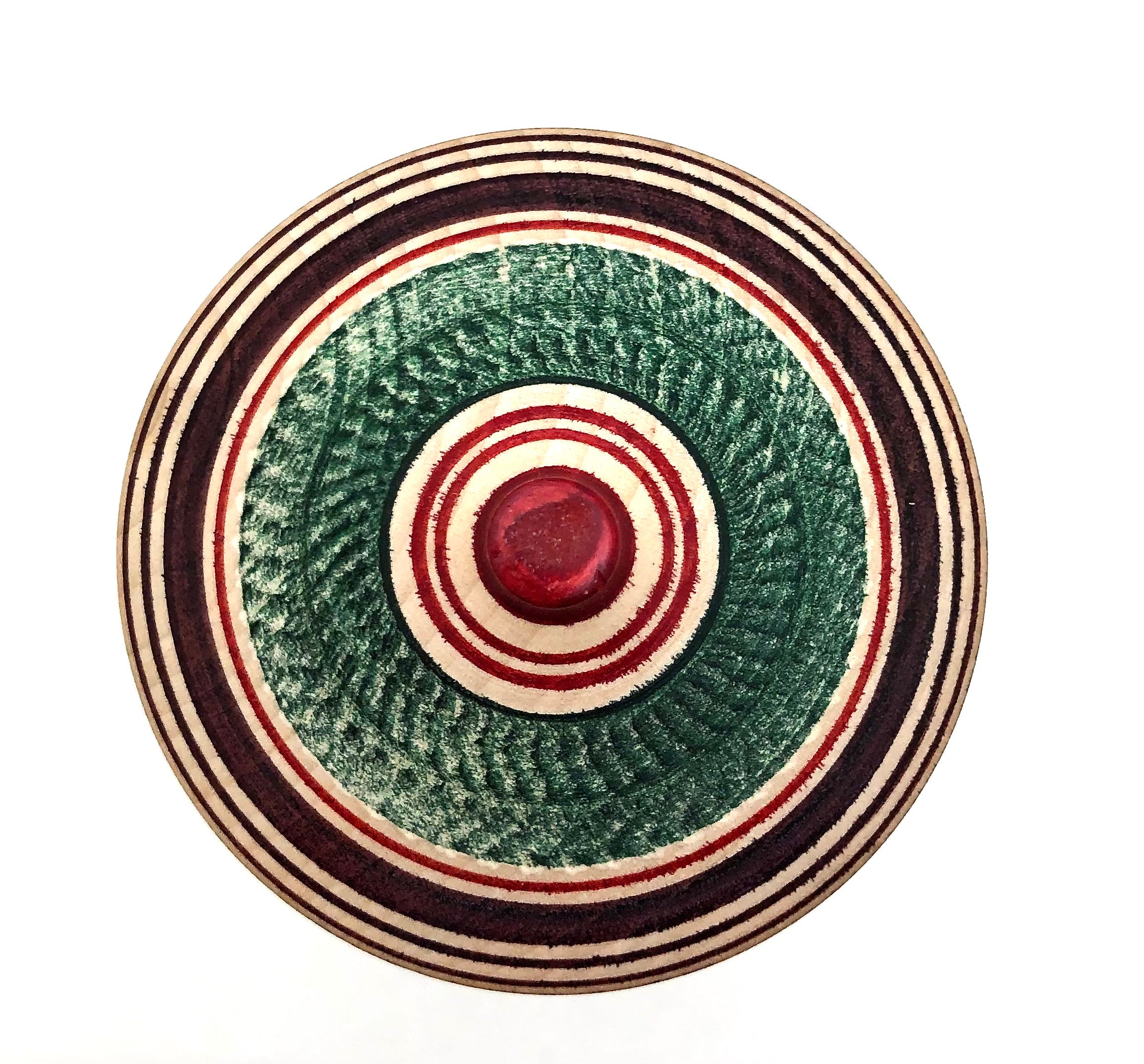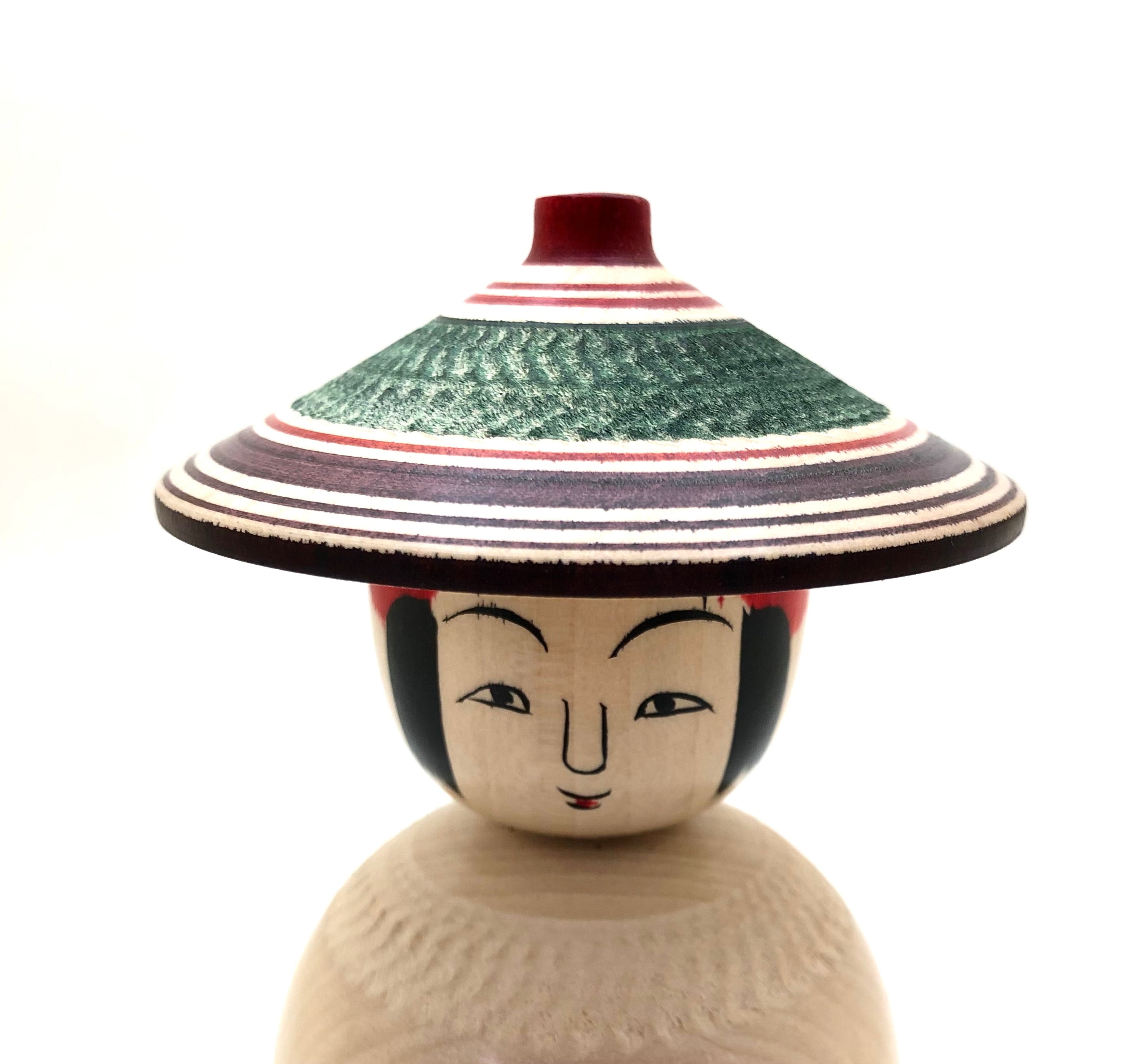




Vintage Traditional Tsuchiyu Kokeshi by Watanabe, Tetsuo
Dimensions: 9-1/2” h
This unusual and very rare variation of the Traditional Tsuchiyu Kokeshi by Watanabe-san, (born 1937-), is from the Fukushima prefecture. There are several very unique features of this doll, beginning with a complicated bulbous body form incorporating “chattering’ on the top of the jacket and base of the figure. Additionally, the carver has incorporated a meticulous treatment of three loose wood rings carved from the same wood as the body and circles the lower portion of the waist. This treatment is referred to as “Yamiyo”, which adds a toy-like element to the form. The second most unique element is a large conical hat known as Sugegasa, an accessory almost forgotten in history. Only on traditional occasions, people are still wearing this Japanese traditional hat. As seen in this Kokeshi, the hat represents a very wide-brimmed style, having concentric circles in red, purple, and green on the top, called Janome, which mimicked lacquered umbrellas, (Kasa). The center of the hat exemplifies the use of “chattering that has a red top knot to finish off this element. The face is framed with black bangs and side hair fringe with red bows and has eyes called Fatae-Mabuta (double lid), a nose called Tare-Bata (long nose), and a simple indication of a mouth with red lips. The piece has its name and is signed by the artist on the bottom of the figure.
For further information see our section entitled “Browse by Family”, Japanese Traditional Kokeshi | Tsuchiyu-Kei (Family).
Condition: Excellent and beautiful condition affording the doll age-old elegance. Retains the original craft/workmanship showing a wonderfully-developed patina commensurate with age and unrestored. The piece meets all the standards of Traditional Kokeshi collectibles and is an exceptional piece for collectors of Tsuchiyu Family dolls.

Japanese Traditional Kokeshi
Tsuchiyu-Kei (Family)
Prefecture: Fukushima
Origin:
Tsuchiyu Family dolls originated in the 1840s at Tsuchiyu Onsen in Fukushima Prefecture, by the work of Sakuma Kamegoro, a kiji-shi who had made various wood items for visitors to the Tsuchiyu Onsen.
Collector's note – characteristics/painting style:
These dolls come in two types: one with a slightly cone-shaped body widening towards the base; and one with a columnar body, tapering where the neck would be. The latter style is also known as the Rokuro Moyo style of circular painting. Artists of this type are famous for being the most accomplished in the circular style of painting, as they take it several steps further by either reversing the line at some point or by zig-zagging the lines periodically. Both add a dynamic element to the dolls.
The design of black, (occasionally purple or green), concentric circles on the top of the head are called Janome. This is known as the ‘snake eye design and is also commonly seen on the tops of paper and lacquered umbrellas (Kasa). The innermost circle of the head is usually colorless. Together with a red bow and a loop on the head, (kase), it is one major characteristic of the Tsuchiyu Kokeshi, along with hairstyles with tufts and bangs. The patterns of the body used to be simple black lines but the lines are drawn in different colors in later models. Some dolls even have patterns of irises and peony flowers between the lines. Most have eyes called futae-mabuta, (double lid), and noses called marubana, (round nose), and tare-bana, (long nose). A few dolls have conspicuously large eyes and noses with blushes around the eyes, similar to the Nakanosawa group.

Leading, Craftsmen:
Abe, Hiroshi, 1998, (Tsuchiyu, Fukushima) - Master: Abe, Kinzo. No additional published information
Abe, Kazue, 1937-2017 - No additional published information
Muramoto, Fumio, 1931-1999 - No additional published information
Namiya, Masao, 1921-2008 - No additional published information
Nishiyama, Kenichi, 1920-2003, (Tsuchiyu, Fukushima) - Master Nishiyama, Katsuji. No additional published information
Obata, Toshio, 1932—2004. Tsuchiyu Lineage. Master Tokumatsu Obata. The eldest son of woodworkers Fukumatsu Obata and Chiyo in Okitama-cho, Fukushima City, Fukushima Prefecture. In 1950, at the age of 18, he began training in woodwork under his father Fukumatsu, and began making wood products to order, but at first, he made many new types of woodwork and also received orders from Tokyo. In 1956, he began making old-style Kokeshi dolls, and made Kokeshi dolls together with his wife Natsuko. He was introduced as the creator in the 1958 edition of the Kokeshi Guide, along with photos of the Kokeshi dolls. He focused on making Kokeshi dolls most around 1960. No additional published information
Ouchi, Ichiji, 1909, (Take, Fukushima) - Master: Ouchi, Kesakichi. No additional published information
Saito, Tokuju, 1926-2021 - Tsuchiyu Lineage. Master: Yamamoto Chisato/Iwaoto Yoshizo. The second son of Shigeru Saito and Fujie, who ran a merchant's inn in Toyoshima, Nishiaizu-cho, Yama-gun, Fukushima Prefecture. In 1948, he found some relief and worked as a self-taught fashion designer and began making souvenir Kokeshi dolls in 1955. In 1956, he moved his place of work to Aizuwakamatsu and received an Encouragement Award at the Fukushima Prefecture Souvenirs Competition and continued making Kokeshi throughout his career. No additional published information
Sato, Chushichi, 1917, (Tsuchiyu, Fukushima) - Master: Sato, Sashima. No additional published information
Sato, Hiromichi, 1930- Master - No additional published information
Sato, Zenji, 1924-1985 - No additional published information
Sakuma, Taichi 1900-1974 - No additional published information
Takahashi, Chuzo, 1893-1981 - No additional published information
Takahashi, Yoshitake, 1927-1995 - No additional published information
Tokunaga, Shinichi - No additional published information
Watanabe, Chuzo, 1921-2008 - No additional published information
Watanabe, Kazuo, 1940-2005 - No additional published information
Watanabe, Sadami 1917-1994 - No additional published information
Watanabe, Hitoshi, 1923, (Tsuchiyu, Fukushima) Master: Sato, Himomichi. No additional published information
Explore & Learn More about Tsuchiyu-Kei (Family)